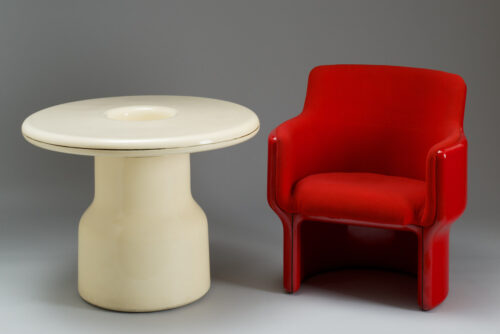Museum of Applied Arts, Budapest [Magyar Iparművészeti Múzeum]
The collection strategy of Budapest’s Museum of Applied Arts, founded in 1872 and covering both the domestic and international scene, was initially determined by a contemporary approach. However, after the First World War, the museum concentrated only on the historical past in the collection. In 1972, the year of the museum’s centenary, the Modern Department was founded, thus reopening the doors to contemporary acquisition. This was when design objects entered the institution en masse, including this table and armchair by Sándor Borz Kováts (1940–73).
The short-lived Sándor Borz Kováts was one of the most talented Hungarian designers of the second half of the twentieth century. However, most of his furniture designs have never been mass-produced, existing only as prototypes like these two pieces. In terms of construction and form, the red armchair is an outstanding work. Actually fabricated by Borz himself, it is made of moulded fiberglass, using a technology often applied in boatbuilding. The chair is not modelled on any particular predecessor, but evokes the spirit of contemporary Italian design.
However, the Modern Department was eventually abolished in 1995 until 2015, when the Contemporary Design Collection of the Museum of Applied Arts was founded with the goal of representing different design and craft developments of the twentieth and twenty-first centuries. Part of our mission is to enhance our collection with the design items that characterized Eastern Europe’s socialist countries before the region’s political transformation.
Countries: Hungary
Tags: Applied art, Housing and living, Product design
